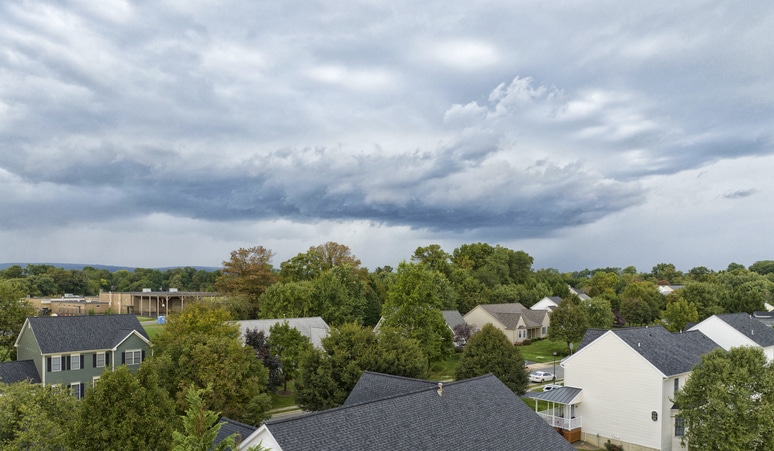Source: Nature Climate Change —
Abstract
Climate change impacts threaten the stability of the US housing market. In response to growing concerns that increasing costs of flooding are not fully captured in property values, we quantify the magnitude of unpriced flood risk in the housing market by comparing the empirical and economically efficient prices for properties at risk. We find that residential properties exposed to flood risk are overvalued by US$121–US$237 billion, depending on the discount rate. In general, highly overvalued properties are concentrated in counties along the coast with no flood risk disclosure laws and where there is less concern about climate change. Low-income households are at greater risk of losing home equity from price deflation, and municipalities that are heavily reliant on property taxes for revenue are vulnerable to budgetary shortfalls. The consequences of these financial risks will depend on policy choices that influence who bears the costs of climate change.
Main
Climate change poses a range of financial and economic risks to households, communities and market sectors across the United States1,2. These risks stem not only from the physical impacts of climate change, but also from how property owners, private companies and public institutions respond to growing climate hazards. Adaptation responses will not only determine the magnitude of total costs, but alsowhether these costs become increasingly borne by American taxpayers, or alternatively become internalized by those who are directly exposed to physical climate impacts3.
Among the natural hazards exacerbated by climate change, flooding is the deadliest, costliest and most widely experienced in the United States4. Currently, more than 14.6 million properties in the United States face at least a 1% annual probability of flooding5, with expected annual damages to residential properties exceeding US$32 billion6. Increasing frequency and severity of flooding under climate change is predicted to increase the number of properties exposed to flooding by 11% (ref. 5) and average annual losses (AALs) by at least 26% by 2050 under Representative Concentration Pathway (RCP) 4.56, presenting substantial costs to property owners, insurers, mortgage lenders and the federal government.
The increasing burden of flooding under climate change has led to growing concerns that housing markets are mispricing these risks, thus causing a real estate bubble to develop7,8,9. While empirical studies have observed an average discount of 4.6% for properties located in the 100 yr flood zone10, recent evidence suggests that this price discount does not fully capture the expected costs of flooding7,11. One study estimated that properties in the 100 yr flood zone could be overvalued by an average of 8.5% of their current value9, not accounting for increasing damages from climate change. This unpriced flood risk could perpetuate perverse incentives for continued development in floodplains and underinvestment in hazard mitigation, further inflating the housing bubble. Despite these concerns, the magnitude, distribution and potential social and economic consequences of overvaluation in US housing markets remain uncertain.
Incomplete pricing of flood risk may be driven by lack of information about potential flood losses, cognitive biases in risk perceptions and/or socialization of flood-related costs (that is, transferred to taxpayers). In many cases, potential buyers may be unaware of a property’s risk because of deficiencies in the Federal Emergency Management Agency (FEMA)’s flood insurance rate maps (FIRMs)12, as well as inconsistent state-level flood risk disclosure laws13. Misperceptions of natural hazards and climate change further limit homebuyers’ ability to rationally price flood risk, as a range of systemic biases may lead to underestimation of the probability and severity of being affected by flooding14. Additionally, subsidization of National Flood Insurance Program (NFIP) premiums and climate-agnostic mortgage lending practices have created distorted price signals by transferring flood-related costs away from property owners15. Only recently are these price signals starting to shift under the NFIP’s new pricing methodology, Risk Rating 2.0, which determines premiums based on individual assessments of flood risk and rebuilding costs for each property16, and as mortgage lenders begin to insulate themselves from credit risk associated with exposure to flood risk17,18,19,20.
While efficient capitalization of flood risk in property prices may reduce the incentive to develop in floodplains, thus decreasing the total costs of flooding, it may also yield negative consequences for flood zone property owners and local governments. In the event of price deflation, many homeowners would be at risk of losing value in their largest asset—their home21. In turn, municipalities that are heavily reliant on property taxes for revenue would be vulnerable to budgetary shortfalls if the assessed values of flood zone properties decline22,23. These potential consequences of the flood risk housing bubble, the time horizon over which they occur, and their effect on the stability of the housing market will largely depend on how policymakers and the multiple players in the housing and mortgage markets respond to increasing flood hazards under climate change.
To better understand the scope and severity of these adaptation risks, we quantify the magnitude and distribution of unpriced flood risk and overvaluation in US housing markets. We further evaluate the potential loss of home equity among demographic groups in the United States and identify municipalities vulnerable to budgetary losses resulting from devaluation of flood zone properties. Finally, we consider possible changes in state and federal policy, as well as mortgage lending practices, that could internalize the costs of flooding among flood zone property owners and lead to widespread price deflation.
Results
We calculate overvaluation of properties exposed to flood risk based on the difference between our estimates of their empirical and economically efficient price discounts. In our efficient price estimates, we account for future damage costs to properties located both inside and outside of the Special Flood Hazard Area (SFHA; that is, the 100 yr flood zone as mapped by FEMA). Based on previous studies9,10,24, we assume that only properties located within the SFHA currently capitalize exposure to flood risk, whereas properties outside of the SFHA do not. We describe two alternative analyses that test the sensitivity of this assumption in the Methods section ‘Sensitivity and uncertainty analyses’.
Following best practices25, we estimate the empirical flood zone price discount using a repeat sales panel model, which controls for time-invariant characteristics of individual properties. Similar to ref. 9, our approach identifies the effect of rezoning properties into the SFHA as the result of FIRM updates over time. To build the panel model, we employ an extensively processed version of the Zillow ZTRAX database26, a comprehensive dataset of property transactions in the United States over the last 30 yrs, joined with newly consolidated historical FIRM layers27 (see Methods). We evaluate variation in the discount of flood zone property prices by accounting for state- and county-level differences in access to flood risk information and perceptions of climate risks. While there are many other factors that may drive heterogeneity in flood risk capitalization, we focused on these two because previous work has shown them to be particularly salient7,9,13,28.
We define the efficient price of properties exposed to flooding as the difference between property values in the absence of flood risk and the net present value (NPV) of AALs from pluvial, fluvial and coastal flooding between 2020 and 2050, accounting for future impacts of climate change under RCP 4.56. This approach leverages newly available national-scale flood inundation maps from the First Street Foundation under a range of recurrence intervals29. To estimate property-specific flood losses, we overlay these maps with the locations of property structures and apply depth-damage functions specified by the FEMA HAZUS model to calculate damage as a proportion of property value30. Unless stated otherwise, all overvaluation estimates are based on the NPV of AALs calculated using a 3% discount rate. Results based on other discount rates are shown in Supplementary Fig. 16.
Empirical flood zone discounts
Across all counties in the conterminous United States, we estimate that properties currently located in the SFHA are discounted by an average of −2.8%. However, flood risk capitalization varies according to differences in state-level flood risk disclosure laws and county-level perceptions of climate risk (Fig. 1a and Supplementary Fig. 7). In counties with no disclosure requirements (Groups A and C in Fig. 1a), we estimate a flood zone discount of −2.4 to −2.5%. In counties with at least one form of disclosure requirement, we estimate flood zone discounts of −9.7% (Group D) and −4.5% (Group B), depending on whether concerns about climate risk in a county are above or below the national median.
Magnitude and distribution of overvaluation
Our comparison of the empirical and efficient price discounts for all properties exposed to flood risk (that is, properties where the NPV of AALs is greater than zero) reveals that properties exposed to flood risk are overvalued by a total of US$121–US$237 billion, depending on the discount rate (Supplementary Fig. 16). Using a 3% discount rate, our preferred value31, total overvaluation is US$187 billion. These estimates assume that properties outside the SFHA do not have a flood risk discount. Under alternative assumptions that properties outside the SFHA do capitalize some amount of their flood risk (see ‘Sensitivity and uncertainty analyses’ in Methods), total overvaluation decreases by 2–22% (Supplementary Figs. 11 and 12). We also show the sensitivity of these results to alternative discount rates and flood hazard scenarios in Supplementary Figs. 9 and 10.
We use several metrics to identify the regions of the United States where the financial and economic risks posed by overvaluation are greatest. Based on the median of property-level overvaluation, in terms of a proportion of properties’ current fair market value, Appalachia and northern New England emerge as overvaluation hotspots (Fig. 1b). These regional trends reflect poor flood risk capitalization and relatively high AALs per property, but do not account for the number or value of properties at risk. When evaluated as a proportion of the total fair market value of all properties in a county, overvaluation remains high in Appalachia, yet is also high along the Gulf and Atlantic coasts (Fig. 1c). In some of these counties, overvaluation as a proportion of the total fair market value of all properties exceeds 10%. However, when evaluated in absolute dollar terms, overvaluation is greatest along the Gulf, Atlantic and Pacific coasts (Fig. 1d), which reflects regional differences in property prices (Supplementary Fig. 2). In particular, properties in Florida are overvalued by more than US$50 billion (Supplementary Fig. 17).
The distribution of overvaluation among properties exposed to flood risk is highly right skewed whereby relatively few properties drive a large proportion of total overvaluation. In dollar terms, 11% of properties contribute 80% of total overvaluation and 19% contribute 90% of overvaluation (Fig. 2d). These acutely overvalued properties have higher average sales prices and are exposed to severe flood damages. In contrast, 55% of flood-exposed properties are overvalued by less than 1% of their value and 76% are overvalued by less than 5% (Fig. 2a). In dollar terms, 90% of flood-exposed properties are overvalued by less than US$50,000 and 94% are overvalued by less than US$100,000 (Fig. 2b).
A large portion of overvaluation is driven by properties located outside of the SFHA. These properties comprise 83% of all properties at risk of flooding and contribute 69% of total overvaluation in dollar terms (Fig. 2). Among properties in the highest decile of overvaluation in dollar terms, 69% are located outside of the SFHA; among properties in the second highest decile of overvaluation, 82% are located outside of the SFHA. While these properties are on average less overvalued (as a proportion of their value) than properties located in the SFHA (Fig. 2c), they still constitute a major source of the total unpriced flood risk in the United States due to their sheer number and less efficient capitalization of exposure to flooding. Under alternative assumptions that properties outside the SFHA do capitalize some amount of their flood risk (see ‘Sensitivity and uncertainty analyses’ in Methods), the portion of total overvaluation from non-SFHA properties decreases to 60–64% (Supplementary Figs. 11 and 12).
Potential impacts of overvaluation among demographic groups
Low-income property owners are at greater risk of losing home equity from property price deflation (Fig. 3a and Supplementary Fig. 13). These findings were derived by aggregating properties by census tract and grouping census tracts by household median income quintiles. Among census tracts in the lowest quintile of household median income, 9.0% of properties are overvalued by >0 to 5%. By contrast, 7.5% of properties in the highest quintile of household median income are overvalued by up to 5%. This trend holds for higher levels of overvaluation as well. For example, 0.8% of properties are overvalued by 50–100% in the lowest income quintile tracts, whereas 0.3% of properties are overvalued by 50–100% in the highest income tracts.
Modest overvaluation (that is, >0–5% of property value) is more widespread in census tracts with a higher percentage non-white population, but whiter tracts have a larger share of highly overvalued properties (that is, 5–100% of property value) (Fig. 3b and Supplementary Fig. 13). In census tracts with the lowest percent population white (not Hispanic or Latino), 11.0% of properties are overvalued by >0 to 5%. By contrast, in census tracts with the highest percentage of white population, 6.7% of properties are overvalued by >0 to 5%. This trend reverses at levels of overvaluation greater than 5%. In tracts in the lowest percent white quintile, 0.3% of properties are overvalued by 50–100%, whereas 1.1% of properties are overvalued by 50–100% in the highest percent white tracts. These demographic trends are less pronounced under the alternative assumptions regarding capitalization of exposure to flood risk among properties located outside of the SFHA (see ‘Sensitivity and uncertainty analyses’ in Methods, and Supplementary Figs. 14 and 15).














